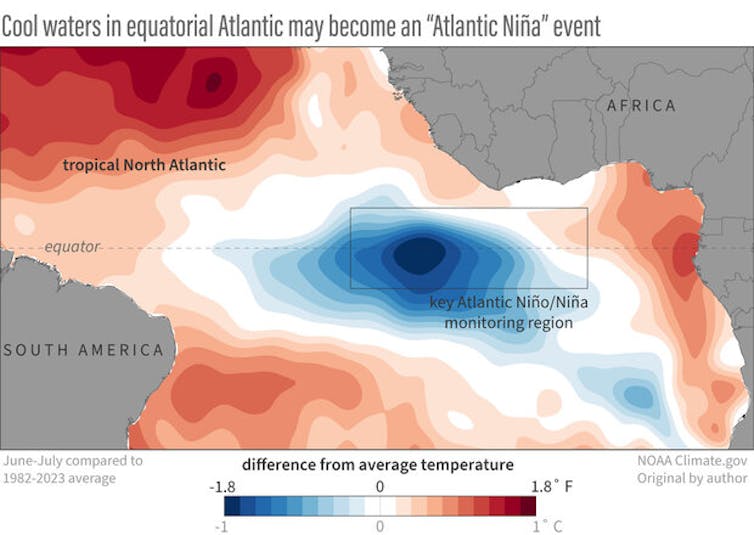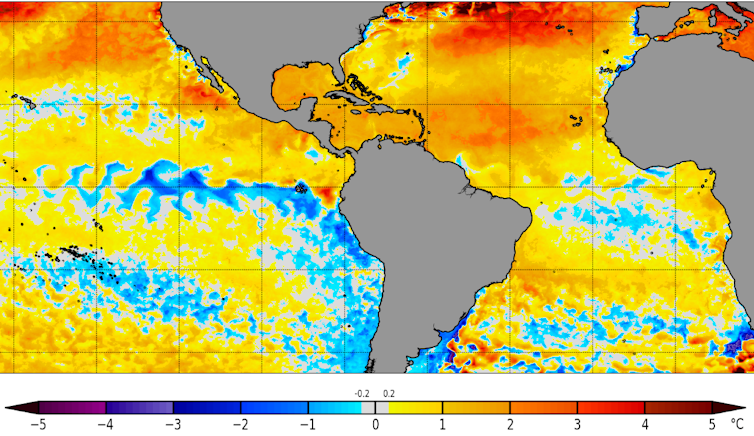The North Atlantic Ocean has been running a fever for months, with surface temperatures at or near record highs. But cooling along the equator in both the Atlantic and eastern Pacific may finally be starting to bring some relief, particularly for vulnerable coral reef ecosystems.
This cooling comes from two climate phenomena with similar names: La Nina, which forms in the tropical Pacific, and the less well-known Atlantic Nina.
Both can affect the Atlantic hurricane season. While La Nina tends to bring conditions ideal for Atlantic hurricanes, the less powerful Atlantic Nina has the potential to reduce some of the hurricane risk.

We're ocean and atmospheric scientists who study this type of climate phenomenon. It's rare to see both Ninas at the same time, yet in August 2024, both appeared to be developing. Let's take a closer look at what that means.
La Nina and its cousin, Atlantic Nina
La Nina is part of the El Nino–Southern Oscillation, a well-known climate phenomenon that has widespread effects on climate and weather around the world.
During La Nina, sea surface temperatures in the tropical Pacific dip below normal. Easterly trade winds then strengthen, allowing more cool water to well up along the equator off South America. That cooling affects the atmosphere in ways that reverberate across the planet. Some areas become stormier and others drier during La Nina, and the wind shear that can tear apart Atlantic hurricanes tends to weaken.
La Nina and its warmer opposite, El Nino, oscillate every three to four years or so.
A similar climate phenomenon, Atlantic Nina, occurs in the Atlantic Ocean but at a much smaller scale and amplitude. It typically peaks around July or August and tends to have a shorter duration than its Pacific cousin and much more modest and local impacts. Atlantic Ninas generally have the opposite effect of Atlantic Ninos, which tend to reduce rainfall over Africa's Sahel region and increase rainfall in Brazil and the countries that surround the Gulf of Guinea, such as Ghana, Nigeria, and Cameroon.
While much weaker than their Pacific counterpart, Atlantic Ninas can, however, partially counteract La Ninas by weakening summer winds that help drive the upwelling that cools the eastern Pacific.
Why are both happening now?
In July and August 2024, meteorologists noted cooling that appeared to be the development of an Atlantic Nina along the equator. The winds at the ocean surface had been weak through most of the summer, and sea surface temperatures there were quite warm until early June, so signs of an Atlantic Nina emerging were a surprise.
At the same time, waters along the equator in the eastern Pacific were also cooling, with La Nina conditions expected there by October or November.

Getting a Pacific-Atlantic Nina combination is rare but not impossible. It's like finding two different pendulums that are weakly coupled to swing in opposite directions moving together in time. The combinations of La Nina and Atlantic Niño, or El Niño and Atlantic Nina are more common.
Good news or bad for hurricane season?
An Atlantic Nina may initially suggest good news for those living in hurricane-prone areas.
Cooler than average waters off the coast of Africa can suppress the formation of African easterly waves. These are clusters of thunderstorm activity that can form into tropical disturbances and eventually tropical storms or hurricanes.
Tropical storms draw energy from the process of evaporating water associated with warm sea surface temperatures. So, cooling in the tropical Atlantic could weaken this process. That would leave less energy for the thunderstorms, which would reduce the probability of a tropical cyclone forming.
However, NOAA takes all factors into account when it updates its Atlantic hurricane season outlook, released in early August, and it still anticipates an extremely active 2024 season. Tropical storm season typically peaks in early to mid-September.
Two reasons are behind the busy forecast: The near record-breaking warm sea surface temperatures in much of the North Atlantic can strengthen hurricanes. And the expected development of a La Nina in the Pacific tends to weaken wind shear – the change in wind speed with height that can tear apart hurricanes. La Nina's much stronger effects can override any impacts associated with the Atlantic Nina.
Exacerbating the problem: Global warming
The past two years have seen exceptionally high ocean temperatures in the Atlantic and around much of the world's oceans. The two Ninas are likely to contribute some cooling relief for certain regions, but it may not last long.
In addition to these cycles, the global warming trend caused by rising greenhouse gas emissions is raising the baseline temperatures and can fuel major hurricanes.![]()
(Authors: Annalisa Bracco, Professor of Ocean and Climate Dynamics, Georgia Institute of Technology and Zachary Handlos, Atmospheric Science Educator, Georgia Institute of Technology)
(This article is republished from The Conversation under a Creative Commons license. Read the original article.)
from NDTV News-World-news https://ift.tt/uHI1MiJ
No comments:
Post a Comment